Uniden BC780XLT User Manual
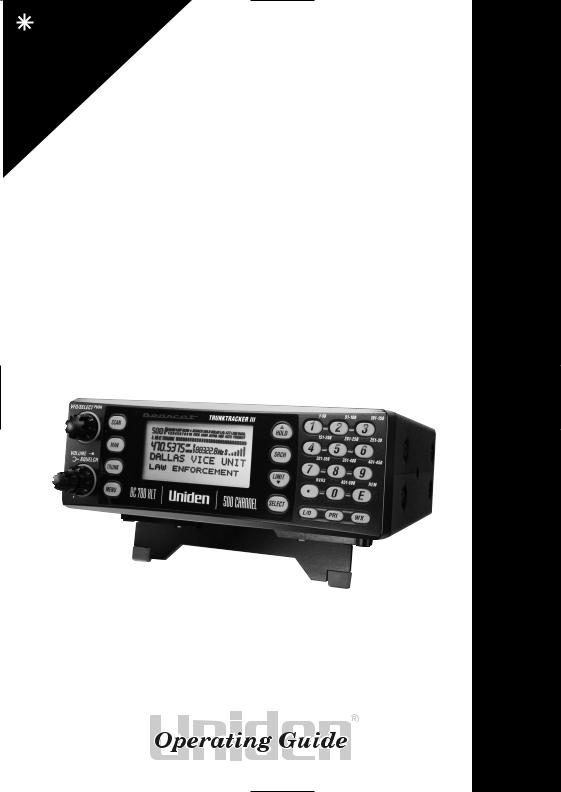
our |
at |
.com |
Visit |
|
|
Website |
|
|
.bc780xlt |
||
www |
|
|
BC780XLT
 TRUNK TRACKER III
TRUNK TRACKER III
Scanner Tracking Trunk Channel-500

Introduction
The BC780XLT is a state-of-the-art radio with TrunkTracking™ and automatic scanning capabilities. It can store frequencies such as police, fire/emergency, marine, railroad, air, amateur, and other communications into 10 banks of 50 channels each.
With the new SmartScanner™ feature, you can also automatically program your scanner by downloading directly from our Uniden/Bearcat national frequency database via a PC or external modem.
Use your new scanner to monitor:
•Police and Fire Departments (including rescue and paramedics)
•VHF High Band, UHF, 800/900MHz Trunked Public Safety Systems
•Trunking for Motorola, EDACS and LTR Systems
•NOAA Weather Broadcasts
•Business/Industrial Radio
•Utilities
•Marine and Amateur (ham radio) Bands
•Air Band
•And much more...
The chart below identifies the scanner band numbers, the frequency range, the modulation mode and the default step size settings.
Band |
Frequency Range |
Mode |
Step |
Band |
Frequency Range |
Mode |
Step |
|
No. |
(MHz) |
|
(kHz) |
No. |
(MHz) |
|
(kHz) |
|
1 |
|
25.0000–26.9600 |
AM |
5 |
22 |
470.0000–472.9875 |
NFM |
12.5 |
2 |
|
26.9650–27.4050 |
AM |
5 |
|
473.0000–475.9875 |
NFM |
12.5 |
3 |
|
27.4100–27.9950 |
AM |
5 |
|
476.0000–478.9875 |
NFM |
12.5 |
4 |
|
28.0000–29.6900 |
FM |
10 |
|
479.0000–481.9875 |
NFM |
12.5 |
5 |
|
29.7000–49.9900 |
FM |
10 |
|
482.0000–484.9875 |
NFM |
12.5 |
6 |
|
50.0000–53.9900 |
FM |
10 |
|
485.0000–487.9875 |
NFM |
12.5 |
7 |
|
54.0000–71.9500 |
WFM |
50 |
|
488.0000–490.9875 |
NFM |
12.5 |
8 |
|
72.0000–75.9950 |
FM |
5 |
|
491.0000–493.9875 |
NFM |
12.5 |
9 |
|
76.0000–87.9500 |
WFM |
50 |
|
494.0000–496.9875 |
NFM |
12.5 |
10 |
|
88.0000–107.9000 |
WFM |
100 |
|
497.0000–499.9875 |
NFM |
12.5 |
11 |
|
108.0000–136.9750 |
AM |
25 |
|
500.0000–502.9875 |
NFM |
12.5 |
12 |
|
137.0000–143.9950 |
FM |
5 |
|
503.0000–505.9875 |
NFM |
12.5 |
13 |
|
144.0000–147.9950 |
FM |
5 |
|
506.0000–508.9875 |
NFM |
12.5 |
14 |
|
148.0000–161.9950 |
FM |
5 |
|
509.0000–511.9875 |
NFM |
12.5 |
|
|
|||||||
|
162.0000–173.9875 |
FM |
12.5 |
|
(470.0000)–512.0000 |
NFM |
12.5 |
|
|
|
|
||||||
15 |
|
174.0000–215.9500 |
WFM |
50 |
23 |
806.0000–823.9875 |
NFM |
12.5 |
16 |
|
216.0000–224.9950 |
FM |
5 |
|
849.0125–850.9875 |
NFM |
12.5 |
17 |
|
225.0000–399.9500 |
AM |
50 |
|
851.0000–868.9875 |
NFM |
12.5 |
18 |
|
400.0000–405.9875 |
NFM |
12.5 |
|
894.0125–895.9875 |
NFM |
12.5 |
19 |
|
406.0000–419.9875 |
NFM |
12.5 |
|
896.0000–901.0000 |
NFM |
12.5 |
20 |
|
420.0000–424.9875 |
NFM |
12.5 |
|
901.0125–934.9875 |
NFM |
12.5 |
|
|
425.0000–429.9875 |
NFM |
12.5 |
|
935.0000–940.0000 |
NFM |
12.5 |
|
|
430.0000–449.9875 |
NFM |
12.5 |
|
940.0125–956.0000 |
NFM |
12.5 |
21 |
|
450.0000–454.9875 |
NFM |
12.5 |
24 |
1240.0000–1300.0000 |
NFM |
12.5 |
|
|
455.0000–459.9875 |
NFM |
12.5 |
|
|
|
|
|
|
460.0000–464.9875 |
NFM |
12.5 |
|
|
|
|
|
|
465.0000–469.9875 |
NFM |
12.5 |
|
|
|
|
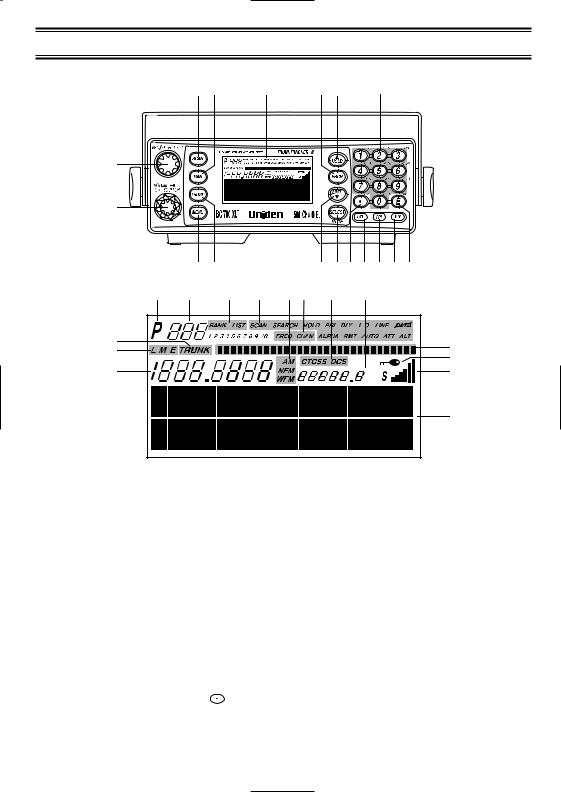
Front View and Display
|
3 |
4 |
5 |
|
|
6 |
7 |
8 |
1 |
|
|
|
|
|
|
|
|
2 |
|
|
|
|
|
|
|
|
|
9 |
10 |
|
|
|
11 12 13 14 15 16 17 |
||
21 |
22 |
23 |
24 |
25 |
26 |
27 |
28 |
|
18 |
|
|
|
|
|
|
|
29 |
19 |
|
|
|
|
|
|
|
30 |
|
|
|
|
|
|
|
|
|
20 |
|
|
|
|
|
|
|
31 |
|
|
|
|
|
|
|
|
32 |
1. |
VFO/SELECT Control |
17. |
Enter/Remote Key (E/REM) |
2. |
VOLUME/SQUELCH Control |
18. |
Trunk Mode Indicator |
3. |
Scan Key (SCAN) |
19. |
Trunk Type Indicators |
4. |
Manual Key (MAN) |
20. |
Frequency Display |
5. |
Display |
21. |
Priority Channel Indicator |
6. |
Search Key (SRCH) |
22. |
Channel Number Display |
7. |
Hold/Up Key (HOLD/▲) |
23. |
Bank/Trunk Scan List Indicator |
8. |
Numeric Keypad (each banks |
24. |
Scanner/Channel Mode Indicators |
|
channel numbers) |
25. |
Receiving Mode Indicators |
9. |
Menu Key (MENU) |
26. |
Frequency/Channel Indicators |
10. |
Trunk Key (TRUNK) |
27. |
CTCSS/DCS Indicators |
11. |
Limit/Down Key (LIMIT/▼) |
28. |
ID/Code/Frequency Display |
12. |
Select/Mute Key (SELECT/MUTE) |
29. |
Trunk Repeater Activity Indicators |
13. |
Decimal/Reverse Key ( /RVRS) |
30. |
Enter Lock Indicator |
14. |
Lockout Key (L/O) |
31. |
Signal Meter |
15. |
Priority Key (PRI) |
32. |
Character Display |
16. |
Weather Key (WX) |
|
|
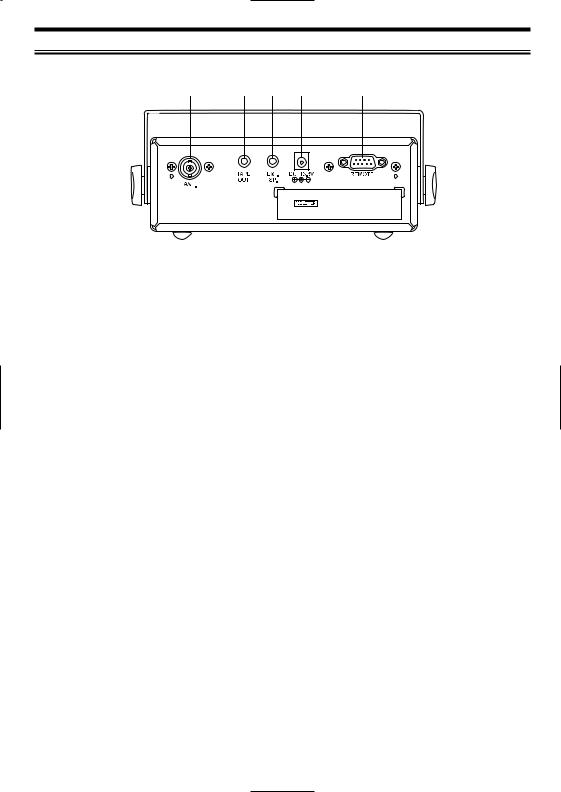
Rear View
33 |
34 |
35 |
36 |
37 |
33. |
Antenna Connector |
35. |
External Speaker Jack |
34. |
Tape Recorder Output Jack |
36. |
DC Power Jack |
|
|
37. |
Remote Control Terminal |
Uniden® and Bearcat® are registered trademarks of Uniden America Corporation. TrunkTrack and SmartScanner are proprietary trademarks of Uniden America Corporation.
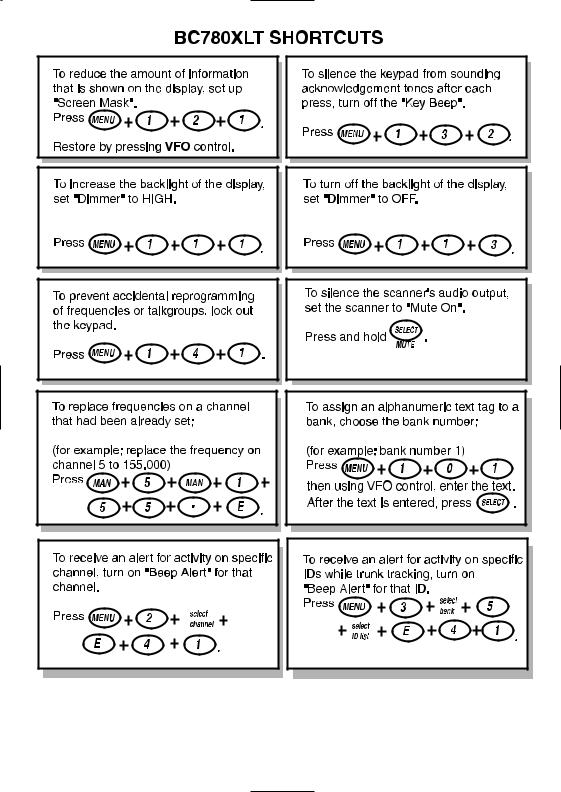
This shortcut card is designed to assist you in getting through the menu screens using the direct entry mode for commonly used features. Please read the manual thoroughly before using this card. Be sure to back out of the menu screen after each shortcut by repeatedly pressing MENU.
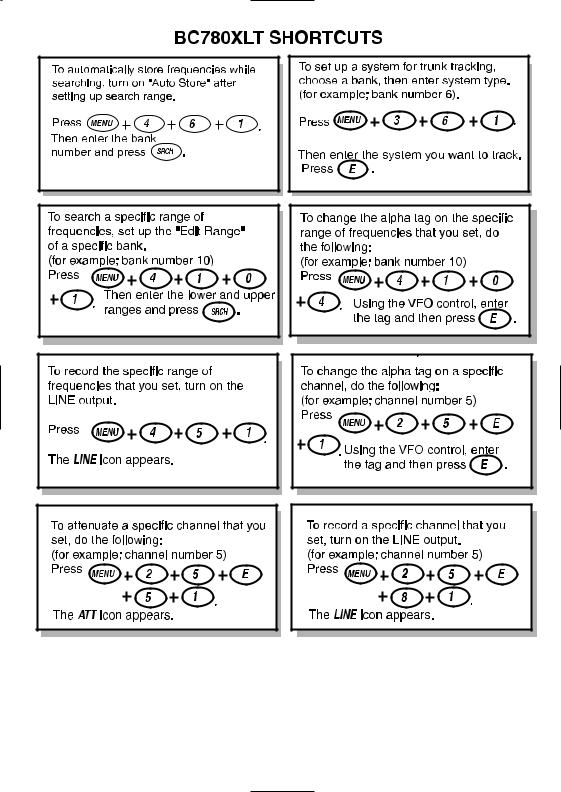
If you need any assistance with this product, please call our Customer Service Hotline at 1-800-297-1023. A Uniden representative will be happy to help you with any matters regarding the operation of this unit, available accessories, or any other related matters. Hours: M-F 7:00 a.m. to 7:00 p.m., Central time.
Also please check out our website at www.uniden.com

Contents
Introduction . . . . . . . . . . . . . . . . . . . . . . . . . . . . . . . . . . . . . . . . . . . . . . . . . . . . . . . . .inside front cover Important Notice . . . . . . . . . . . . . . . . . . . . . . . . . . . . . . . . . . . . . . . . . . . . . . . . . . . . . . . . . . . . . . . . .1
Terminology . . . . . . . . . . . . . . . . . . . . . . . . . . . . . . . . . . . . . . . . . . . . . . . . . . . . . . . . . . . . . . . . . . . . .2 What is Scanning? . . . . . . . . . . . . . . . . . . . . . . . . . . . . . . . . . . . . . . . . . . . . . . . . . . . . . . . . . . . . . .2 What is Searching? . . . . . . . . . . . . . . . . . . . . . . . . . . . . . . . . . . . . . . . . . . . . . . . . . . . . . . . . . . . . .2 What is Trunk Tracking? . . . . . . . . . . . . . . . . . . . . . . . . . . . . . . . . . . . . . . . . . . . . . . . . . . . . . . . . . .2
Feature Highlights . . . . . . . . . . . . . . . . . . . . . . . . . . . . . . . . . . . . . . . . . . . . . . . . . . . . . . . . . . . . . . . .4
Where to Obtain More Information . . . . . . . . . . . . . . . . . . . . . . . . . . . . . . . . . . . . . . . . . . . . . . . . . . . .5 Information on the Internet . . . . . . . . . . . . . . . . . . . . . . . . . . . . . . . . . . . . . . . . . . . . . . . . . . . . . . . .5
Included with Your Scanner . . . . . . . . . . . . . . . . . . . . . . . . . . . . . . . . . . . . . . . . . . . . . . . . . . . . . . . . . |
6 |
Setup . . . . . . . . . . . . . . . . . . . . . . . . . . . . . . . . . . . . . . . . . . . . . . . . . . . . . . . . . . . . . . . . . . . . . . . . . .7 Connecting an Antenna . . . . . . . . . . . . . . . . . . . . . . . . . . . . . . . . . . . . . . . . . . . . . . . . . . . . . . . . . .7
Mounting an Antenna . . . . . . . . . . . . . . . . . . . . . . . . . . . . . . . . . . . . . . . . . . . . . . . . . . . . . . . . . . . .7 Optional Antenna . . . . . . . . . . . . . . . . . . . . . . . . . . . . . . . . . . . . . . . . . . . . . . . . . . . . . . . . . . . . . . .7 Typical Mounting Methods . . . . . . . . . . . . . . . . . . . . . . . . . . . . . . . . . . . . . . . . . . . . . . . . . . . . . . . .8 Mounting the Scanner in Your Vehicle . . . . . . . . . . . . . . . . . . . . . . . . . . . . . . . . . . . . . . . . . . . . . . . .8 Applying Power for Vehicle Installation . . . . . . . . . . . . . . . . . . . . . . . . . . . . . . . . . . . . . . . . . . . . . . .9 Desktop Installation . . . . . . . . . . . . . . . . . . . . . . . . . . . . . . . . . . . . . . . . . . . . . . . . . . . . . . . . . . . .10 Applying Power Using Standard AC Power . . . . . . . . . . . . . . . . . . . . . . . . . . . . . . . . . . . . . . . . . . .10 Connecting an External Speaker . . . . . . . . . . . . . . . . . . . . . . . . . . . . . . . . . . . . . . . . . . . . . . . . . . .10 Connecting an Earphone . . . . . . . . . . . . . . . . . . . . . . . . . . . . . . . . . . . . . . . . . . . . . . . . . . . . . . . .11 Listening Safely . . . . . . . . . . . . . . . . . . . . . . . . . . . . . . . . . . . . . . . . . . . . . . . . . . . . . . . . . . . . . . .11 Connecting the Clone Cable . . . . . . . . . . . . . . . . . . . . . . . . . . . . . . . . . . . . . . . . . . . . . . . . . . . . . .11 Connecting the Tape Recorder . . . . . . . . . . . . . . . . . . . . . . . . . . . . . . . . . . . . . . . . . . . . . . . . . . . .11 Remote Programming Software . . . . . . . . . . . . . . . . . . . . . . . . . . . . . . . . . . . . . . . . . . . . . . . . . . .11
Basic Operation . . . . . . . . . . . . . . . . . . . . . . . . . . . . . . . . . . . . . . . . . . . . . . . . . . . . . . . . . . . . . . . . .12 Turn the Scanner On . . . . . . . . . . . . . . . . . . . . . . . . . . . . . . . . . . . . . . . . . . . . . . . . . . . . . . . . . . .12 Setting the Squelch . . . . . . . . . . . . . . . . . . . . . . . . . . . . . . . . . . . . . . . . . . . . . . . . . . . . . . . . . . . .12 Understanding the Menu System . . . . . . . . . . . . . . . . . . . . . . . . . . . . . . . . . . . . . . . . . . . . . . . . . .13 Menu Description and Numeric Keypad Equivalents . . . . . . . . . . . . . . . . . . . . . . . . . . . . . . . . . . . .14
Programming . . . . . . . . . . . . . . . . . . . . . . . . . . . . . . . . . . . . . . . . . . . . . . . . . . . . . . . . . . . . . . . . . . |
.20 |
Storing Frequencies into Channels . . . . . . . . . . . . . . . . . . . . . . . . . . . . . . . . . . . . . . . . . . . . . . . . . |
20 |
Duplicate Frequency Alert . . . . . . . . . . . . . . . . . . . . . . . . . . . . . . . . . . . . . . . . . . . . . . . . . . . . . . . . |
21 |
Storing Text Tags . . . . . . . . . . . . . . . . . . . . . . . . . . . . . . . . . . . . . . . . . . . . . . . . . . . . . . . . . . . . . . |
21 |
Beep Alert . . . . . . . . . . . . . . . . . . . . . . . . . . . . . . . . . . . . . . . . . . . . . . . . . . . . . . . . . . . . . . . . . . . |
22 |
Programming Tips . . . . . . . . . . . . . . . . . . . . . . . . . . . . . . . . . . . . . . . . . . . . . . . . . . . . . . . . . . . . . |
22 |
Deleting a Stored Frequency . . . . . . . . . . . . . . . . . . . . . . . . . . . . . . . . . . . . . . . . . . . . . . . . . . . . . |
22 |
Scanning . . . . . . . . . . . . . . . . . . . . . . . . . . . . . . . . . . . . . . . . . . . . . . . . . . . . . . . . . . . . . . . . . . . . . .23 RF Attenuation Feature . . . . . . . . . . . . . . . . . . . . . . . . . . . . . . . . . . . . . . . . . . . . . . . . . . . . . . . . .24 Setting the Delay Mode . . . . . . . . . . . . . . . . . . . . . . . . . . . . . . . . . . . . . . . . . . . . . . . . . . . . . . . . .24
Channel Lockout . . . . . . . . . . . . . . . . . . . . . . . . . . . . . . . . . . . . . . . . . . . . . . . . . . . . . . . . . . . . . .25 Restoring a Locked-out Channel . . . . . . . . . . . . . . . . . . . . . . . . . . . . . . . . . . . . . . . . . . . . . . . . . . .26 Restoring All Locked-out Channels . . . . . . . . . . . . . . . . . . . . . . . . . . . . . . . . . . . . . . . . . . . . . . . ..26 Priority Scan . . . . . . . . . . . . . . . . . . . . . . . . . . . . . . . . . . . . . . . . . . . . . . . . . . . . . . . . . . . . . . . . . .26 Changing the Priority Channel . . . . . . . . . . . . . . . . . . . . . . . . . . . . . . . . . . . . . . . . . . . . . . . . . . . .27
Searching . . . . . . . . . . . . . . . . . . . . . . . . . . . . . . . . . . . . . . . . . . . . . . . . . . . . . . . . . . . . . . . . . . . . .28 Setting a Search Range . . . . . . . . . . . . . . . . . . . . . . . . . . . . . . . . . . . . . . . . . . . . . . . . . . . . . . . . .28 Search Hold Feature . . . . . . . . . . . . . . . . . . . . . . . . . . . . . . . . . . . . . . . . . . . . . . . . . . . . . . . . . . .29 Data Skip . . . . . . . . . . . . . . . . . . . . . . . . . . . . . . . . . . . . . . . . . . . . . . . . . . . . . . . . . . . . . . . . . . . .29 Frequency Skip . . . . . . . . . . . . . . . . . . . . . . . . . . . . . . . . . . . . . . . . . . . . . . . . . . . . . . . . . . . . . . .29 Storing Search Frequencies . . . . . . . . . . . . . . . . . . . . . . . . . . . . . . . . . . . . . . . . . . . . . . . . . . . . . .30 Auto Storing . . . . . . . . . . . . . . . . . . . . . . . . . . . . . . . . . . . . . . . . . . . . . . . . . . . . . . . . . . . . . . . . . .30 Squelch (SQ) Mode . . . . . . . . . . . . . . . . . . . . . . . . . . . . . . . . . . . . . . . . . . . . . . . . . . . . . . . . . . . .31 Additional Menu Options for Searching . . . . . . . . . . . . . . . . . . . . . . . . . . . . . . . . . . . . . . . . . . . . . .32
i

Service Search . . . . . . . . . . . . . . . . . . . . . . . . . . . . . . . . . . . . . . . . . . . . . . . . . . . . . . . . . . . . . . . . .33 Service Search Skip . . . . . . . . . . . . . . . . . . . . . . . . . . . . . . . . . . . . . . . . . . . . . . . . . . . . . . . . . . . .33 Weather Channel Search . . . . . . . . . . . . . . . . . . . . . . . . . . . . . . . . . . . . . . . . . . . . . . . . . . . . . . . .34 NWR-SAME Alert . . . . . . . . . . . . . . . . . . . . . . . . . . . . . . . . . . . . . . . . . . . . . . . . . . . . . . . . . . . . . .34 Testing the Alert Siren . . . . . . . . . . . . . . . . . . . . . . . . . . . . . . . . . . . . . . . . . . . . . . . . . . . . . . . . . .34 Programming FIPS Code . . . . . . . . . . . . . . . . . . . . . . . . . . . . . . . . . . . . . . . . . . . . . . . . . . . . . . . ..35
Trunked Systems . . . . . . . . . . . . . . . . . . . . . . . . . . . . . . . . . . . . . . . . . . . . . . . . . . . . . . . . . . . . . . . .36
Programming and Receiving Trunked Systems . . . . . . . . . . . . . . . . . . . . . . . . . . . . . . . . . . . . . . . . . .37 Programming Trunking Frequencies . . . . . . . . . . . . . . . . . . . . . . . . . . . . . . . . . . . . . . . . . . . . . . . .37 Selecting Trunking Programming Menu Mode . . . . . . . . . . . . . . . . . . . . . . . . . . . . . . . . . . . . . . . . .38 Selecting Trunking System Type . . . . . . . . . . . . . . . . . . . . . . . . . . . . . . . . . . . . . . . . . . . . . . . . . . .38 Setting the Squelch . . . . . . . . . . . . . . . . . . . . . . . . . . . . . . . . . . . . . . . . . . . . . . . . . . . . . . . . . . . .39 Receiving Trunked Systems . . . . . . . . . . . . . . . . . . . . . . . . . . . . . . . . . . . . . . . . . . . . . . . . . . . . . .39 Trunked Search . . . . . . . . . . . . . . . . . . . . . . . . . . . . . . . . . . . . . . . . . . . . . . . . . . . . . . . . . . . . . . .39 ID Hold and Direct Entry ID Hold Mode . . . . . . . . . . . . . . . . . . . . . . . . . . . . . . . . . . . . . . . . . . . . . .40 ID Lockout . . . . . . . . . . . . . . . . . . . . . . . . . . . . . . . . . . . . . . . . . . . . . . . . . . . . . . . . . . . . . . . . . . .40 Restoring Locked-out IDs . . . . . . . . . . . . . . . . . . . . . . . . . . . . . . . . . . . . . . . . . . . . . . . . . . . . . . . .41 Channel Activity Indicators . . . . . . . . . . . . . . . . . . . . . . . . . . . . . . . . . . . . . . . . . . . . . . . . . . . . . . .41 Scan Lists . . . . . . . . . . . . . . . . . . . . . . . . . . . . . . . . . . . . . . . . . . . . . . . . . . . . . . . . . . . . . . . . . . .42 Programming ID Scan Lists Manually . . . . . . . . . . . . . . . . . . . . . . . . . . . . . . . . . . . . . . . . . . . . . . .42 ID Scan Mode . . . . . . . . . . . . . . . . . . . . . . . . . . . . . . . . . . . . . . . . . . . . . . . . . . . . . . . . . . . . . . . .44 Setting Priority in Trunking Mode . . . . . . . . . . . . . . . . . . . . . . . . . . . . . . . . . . . . . . . . . . . . . . . . . .45 Programming Scan Lists During Search . . . . . . . . . . . . . . . . . . . . . . . . . . . . . . . . . . . . . . . . . . . . .45 Deleting a Stored ID . . . . . . . . . . . . . . . . . . . . . . . . . . . . . . . . . . . . . . . . . . . . . . . . . . . . . . . . . . . .45 Moving between Scan List Memories . . . . . . . . . . . . . . . . . . . . . . . . . . . . . . . . . . . . . . . . . . . . . . .45 I-Call (Motorola/EDACS) . . . . . . . . . . . . . . . . . . . . . . . . . . . . . . . . . . . . . . . . . . . . . . . . . . . . . . . . .46 Multi-Track . . . . . . . . . . . . . . . . . . . . . . . . . . . . . . . . . . . . . . . . . . . . . . . . . . . . . . . . . . . . . . . . . . .47
EDACS Reception . . . . . . . . . . . . . . . . . . . . . . . . . . . . . . . . . . . . . . . . . . . . . . . . . . . . . . . . . . . . . . .49 EDACS Tracking . . . . . . . . . . . . . . . . . . . . . . . . . . . . . . . . . . . . . . . . . . . . . . . . . . . . . . . . . . . . . . .49 Programming System Frequencies . . . . . . . . . . . . . . . . . . . . . . . . . . . . . . . . . . . . . . . . . . . . . . . . .49 An EDACS trunked System . . . . . . . . . . . . . . . . . . . . . . . . . . . . . . . . . . . . . . . . . . . . . . . . . . . . . .50 Special EDACS Features . . . . . . . . . . . . . . . . . . . . . . . . . . . . . . . . . . . . . . . . . . . . . . . . . . . . . . . .51
LTR Reception . . . . . . . . . . . . . . . . . . . . . . . . . . . . . . . . . . . . . . . . . . . . . . . . . . . . . . . . . . . . . . . . . .52 LTR Tracking . . . . . . . . . . . . . . . . . . . . . . . . . . . . . . . . . . . . . . . . . . . . . . . . . . . . . . . . . . . . . . . . . .52
Motorola Reception . . . . . . . . . . . . . . . . . . . . . . . . . . . . . . . . . . . . . . . . . . . . . . . . . . . . . . . . . . . . . .53 Motorola Tracking . . . . . . . . . . . . . . . . . . . . . . . . . . . . . . . . . . . . . . . . . . . . . . . . . . . . . . . . . . . . . .53 Fleet Map Programming . . . . . . . . . . . . . . . . . . . . . . . . . . . . . . . . . . . . . . . . . . . . . . . . . . . . . . . . .54 Selecting a Preset Fleet Map . . . . . . . . . . . . . . . . . . . . . . . . . . . . . . . . . . . . . . . . . . . . . . . . . . . . .54 Programming a Fleet Map . . . . . . . . . . . . . . . . . . . . . . . . . . . . . . . . . . . . . . . . . . . . . . . . . . . . . . .54 Programming a Hybrid System . . . . . . . . . . . . . . . . . . . . . . . . . . . . . . . . . . . . . . . . . . . . . . . . . . . .55 Setting the Base, Spacing Frequencies and Offset Channel for Motorola VHF/UHF Trunked Systems .55 Toggling the Status Bit . . . . . . . . . . . . . . . . . . . . . . . . . . . . . . . . . . . . . . . . . . . . . . . . . . . . . . . . . .56 Control Channel Only Mode . . . . . . . . . . . . . . . . . . . . . . . . . . . . . . . . . . . . . . . . . . . . . . . . . . . . . .57 Disconnect Tone Detect Option . . . . . . . . . . . . . . . . . . . . . . . . . . . . . . . . . . . . . . . . . . . . . . . . . . . .58
Remote Interface . . . . . . . . . . . . . . . . . . . . . . . . . . . . . . . . . . . . . . . . . . . . . . . . . . . . . . . . . . . . . . . .59
SmartScan Mode . . . . . . . . . . . . . . . . . . . . . . . . . . . . . . . . . . . . . . . . . . . . . . . . . . . . . . . . . . . . . .59 Menu for SmartScan . . . . . . . . . . . . . . . . . . . . . . . . . . . . . . . . . . . . . . . . . . . . . . . . . . . . . . . . . . . .62 SmartScanner Tips . . . . . . . . . . . . . . . . . . . . . . . . . . . . . . . . . . . . . . . . . . . . . . . . . . . . . . . . . . . . .63 Remote (PC Control) Mode . . . . . . . . . . . . . . . . . . . . . . . . . . . . . . . . . . . . . . . . . . . . . . . . . . . . . .65 Clone Mode . . . . . . . . . . . . . . . . . . . . . . . . . . . . . . . . . . . . . . . . . . . . . . . . . . . . . . . . . . . . . . . . . .66
Additional Features . . . . . . . . . . . . . . . . . . . . . . . . . . . . . . . . . . . . . . . . . . . . . . . . . . . . . . . . . . . . . .68 Care and Maintenance . . . . . . . . . . . . . . . . . . . . . . . . . . . . . . . . . . . . . . . . . . . . . . . . . . . . . . . . . . . .70 Troubleshooting . . . . . . . . . . . . . . . . . . . . . . . . . . . . . . . . . . . . . . . . . . . . . . . . . . . . . . . . . . . . . . . . .71 Specifications . . . . . . . . . . . . . . . . . . . . . . . . . . . . . . . . . . . . . . . . . . . . . . . . . . . . . . . . . . . . . . . . . . .73 Glossary of Terms . . . . . . . . . . . . . . . . . . . . . . . . . . . . . . . . . . . . . . . . . . . . . . . . . . . . . . . . . . . . . . .74
Appendix . . . . . . . . . . . . . . . . . . . . . . . . . . . . . . . . . . . . . . . . . . . . . . . . . . . . . . . . . . . . . . . . . . . . . .77
One Year Limited Warranty . . . . . . . . . . . . . . . . . . . . . . . . . . . . . . . . . . . . . . . . . . . . . |
inside back cover |
ii

Important Notice
•This scanning radio has been manufactured so that it will not tune radio frequencies assigned by the FCC for cellular telephone usage. The Electronic Communications Privacy Act of 1986, as amended, makes it a federal crime to intentionally intercept cellular or cordless telephone transmissions or to market this radio when altered to receive them.
•The installation, possession, or use of this scanning radio in a motor vehicle may be prohibited, regulated, or require a permit in certain states, cities, and/or local jurisdictions. Your local law enforcement officials should be able to provide you with information regarding the laws in your community.
•Changes or modifications to this product not expressly approved by Uniden, or operation of this product in any way other than as detailed by this Operating Guide. These violations could void your authority to operate this product.
•The screen displays used in this manual are representations of what might appear when you use your scanner.
1

Terminology
What is Scanning?
Unlike standard AM or FM radio stations, most two-way communications do not transmit continuously. The BC780XLT scans the channels you program until it finds an active frequency.
Scanning stops on an active frequency and remains on that channel as long as the transmission continues. When the transmission ends, the scanning cycle resumes until another transmission is received.
What is Searching?
The BC780XLT can search each of its 24 bands to find active frequencies. This is different from scanning because you are searching for frequencies that have not been programmed into your scanner. The scanner automatically chooses between two speeds while searching. Turbo Search, can search the VHF FM bands at up to 300 channels per second.
What is Trunk Tracking?
Conventional scanning is a simple concept. You enter a radio frequency in your scanner’s memory which is used by someone you want to monitor. For example, the police in your area may broadcast on 460.500 MHz, the fire department on 154.445 MHz, the highway department on 37.900 MHz, etc. So when your scanner stops on a frequency, you usually know who it is, and more importantly, you can stop on a channel and listen to an entire conversation. This type of scanning is easy and fun.
As the demand for public communications has increased, many public radio users don't have enough frequencies to meet their needs, and this has created a serious problem. Trunking radio systems solve this problem.
In a trunked radio system, which contains up to 28 different frequencies, radio users are divided into groups, often called talkgroups, and these talkgroups are assigned specific IDs. When someone in a talkgroup uses their radio, a brief burst of data is broadcasted before each transmission. The trunking system computer uses this data to temporarily assign each radio in a talkgroup to an available frequency. If the group using a frequency stops broadcasting or pauses between replies for a few seconds, they are removed from the frequency so another talkgroup can use it.
Sharing of the available public service frequencies, or trunking, allows cities, counties, or other agencies to accommodate hundreds of users with relatively few frequencies. Following a conversation on a trunked system using a scanner is difficult, if not impossible. Because when there's a short break during the conversation you're monitoring, it’s possible that the talkgroup will be assigned to a completely different frequency in the trunked system. This type of scanning is difficult and frustrating.
2

TrunkTrack™ changes this! Not only does your new BC780XLT scan channels like a conventional scanner, it actually follows the users of a trunked radio system. Once you know a talkgroups ID, you won’t miss any of the action.
If you're a new scanner enthusiast, you may want to read the first part of this manual and use your scanner in conventional mode before you begin trunk tracking. Understanding scanning fundamentals and its terminology will make trunk tracking much easier. A glossary of other commonly used terms is provided in the back. (Refer to the “Glossary of Terms” section.) But if you're already an experienced scanner operator, you may want to skip to Trunked System on page 36.
3

Feature Highlights
•Trunk Tracking – Follows VHF High Band, UHF, 800/900MHz trunked public safety and public service systems just as if conventional two-way communications were used.
•Multi-Track – Track more than one trunking system at a time. Scan conventional and trunked systems at the same time.
•500 Channels – Program one frequency into each channel. You must have at least one channel programmed to use the Scan mode.
•24 Bands, 10 Banks – Includes 24 bands, with Aircraft and 800 MHz.10 banks with 50 channels each are useful for storing similar frequencies to maintain faster scanning cycles or for storing all the frequencies of a trunked system.
•25 MHz-1300 MHz – Indicates the range of frequencies that can be searched within the bands of your scanner.
Note: The frequency coverage is not continuous and excludes the cellular band, 512-806MHz.
•10 Priority Channels – You can assign one priority channel in each bank. Assigning a priority channel allows you to keep track of activity on your most important channel(s) while monitoring other channels for transmissions. You can also assign trunking priority talkgroups.
•Preprogrammed Service (SVC) Search – Allows you to toggle through preprogrammed public safety, news media, TV broadcast audio, Ham, CB, FRS, special low power, railroad, aircraft, marine, and weather frequencies.
•Unique Data Skip – Allows your scanner to skip unwanted data transmissions and reduces birdies.
•Memory Backup – If the battery completely discharges or if power is disconnected, the frequencies programmed in your scanner are retained in memory.
•Manual Channel Access – Go directly to any channel.
•Attenuator – Reduces the signal strength on a per frequency basis.
•SmartScanner™ – Automatically program your BC780XLT with all the frequencies and trunking talkgroups for your local area by accessing our national database with your personal computer (PC) or just an external modem. (No PC required)
•Turbo Search – Increases the search speed to 300 steps per second. This applies only to transmission bands with 5 kHz steps.
• Text Tags – You can customize your scanner by storing text tags (up to 16 characters).
•Auto Store – The scanner automatically arranges a memory store for searched frequencies.
•CTCSS/DCS – The scanner can receive and search for subaudible tones.
•NWR-SAME Alert – The scanner is compatible with warning tone and message transmissions.
•FIPS Code – Six digit FIPS Code (emergency and geographic area code) programmable.
4

Where to Obtain
More Information
Before using your scanner, you must program frequencies into available channels. The Betty Bearcat Frequency Guide lists typical frequencies used around the U.S.A. and Canada that you may program into your new scanner.
To obtain another copy of the frequency guide, contact one of the following:
•Uniden Parts Department
(800)554-3988 (Hours are from 7:00 a.m. to 5:00 p.m. Central Time Monday through Friday.)
•Local Dealer
To obtain additional frequency information for your area, contact one of the following:
•Scanner Master
(800)722-6701 (Hours are from 10:00 a.m. to 5:00 p.m. Eastern Time Monday through Friday.)
•Bearcat Frequency Hotline
(937)299-0414 (Hours are from 9:00 a.m. to 5:00 p.m. Eastern Time Monday through Friday.)
Information on the Internet
If you have access to the Internet, you may want to visit www.trunktracker.com or www.bearcat1.com/free.htm
A special website has been specifically setup for this scanner with helpful information on using this scanner and other user comments. Visit www.bc780xlt.com.
For more information about Uniden and our other products, visit www.uniden.com
5
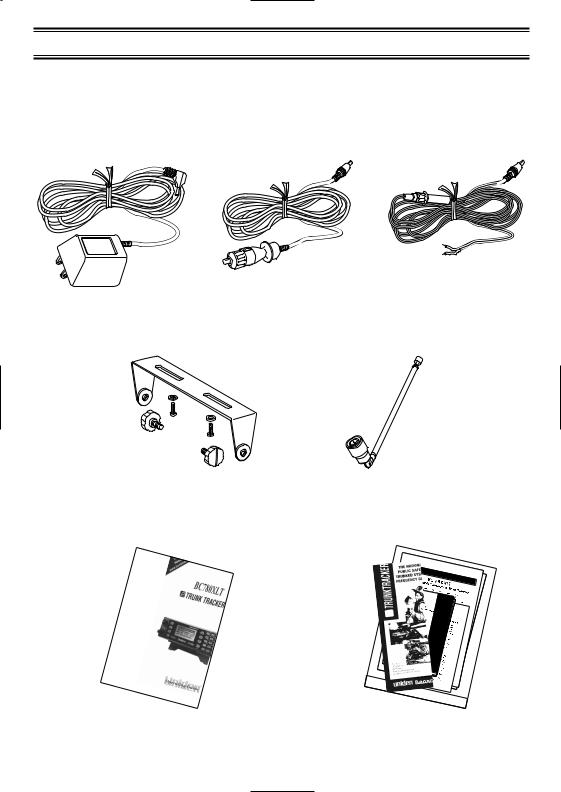
Included with Your Scanner
If any of these items are missing or damaged, immediately contact your place of purchase or Uniden Customer Service at: (800) 297-1023, 7:00 a.m. to 7:00 p.m., Central Time, Monday through Friday.
• AC Adapter |
• Cigarette Lighter |
• DC Cord |
|
Adapter Cord |
|
• Mounting Bracket |
• Telescopic Antenna |
• Operating Guide |
• Trunk Tracker Frequency Guide |
|
and Other Printed Material |
6

Setup
Connecting an Antenna
You must install an antenna before you can operate the scanner. You have been provided a standard telescopic antenna that works well with this scanner, but you may want to purchases another type to increase the range. To connect the telescopic antenna, simply connect it to the BNC type ANT. connector on the rear of the scanner. You can purchase a variety of scanner antennas for both mobile and base station available at a local electronics store. Choose the one that best meets your needs.
When deciding on a mobile or base station antenna and its location, consider these points.
•The antenna should be as high as possible on a vehicle or a house.
•The antenna and its cable should be as far as possible from sources of electrical noise (ignition systems, gauges, and so on).
•The antenna should be vertical for the best performance.
Mounting an Antenna
Once you choose an antenna, follow the mounting instructions supplied with the antenna. Then route the antenna cable to the scanner.
The antenna connector on your scanner makes it easy to use the scanner with a variety of antennas, such as an external mobile antenna or an outdoor base station antenna.
Always use 50 ohm coaxial cable, such as RG-58 or RG-8, to connect an outdoor antenna. For lengths over 50 feet, use RG-8 low-loss dielectric coaxial cable. If your antenna’s cable does not have a BNC connector, you will also need a BNC adapter (available at a local electronics store).
Follow the Installation instructions supplied with the antenna, route the antenna cable to the scanner, then connect it to the ANT. jack.
Warning: Use extreme caution when you install or remove an outdoor antenna. If the antenna starts to fall, let it go! It could contact overhead power lines. If the antenna touches a power line, contact with the antenna, mast, cable, or guy wires can cause electrocution and death. Call the power company to remove the antenna. DO NOT attempt to do it yourself.
Optional Antenna
If you have chosen an optional mobile antenna, connect the antenna plug into the ANT connector on the rear of the scanner. (For more information on antenna installation, please refer to the instruction guide that came with your antenna.)
7
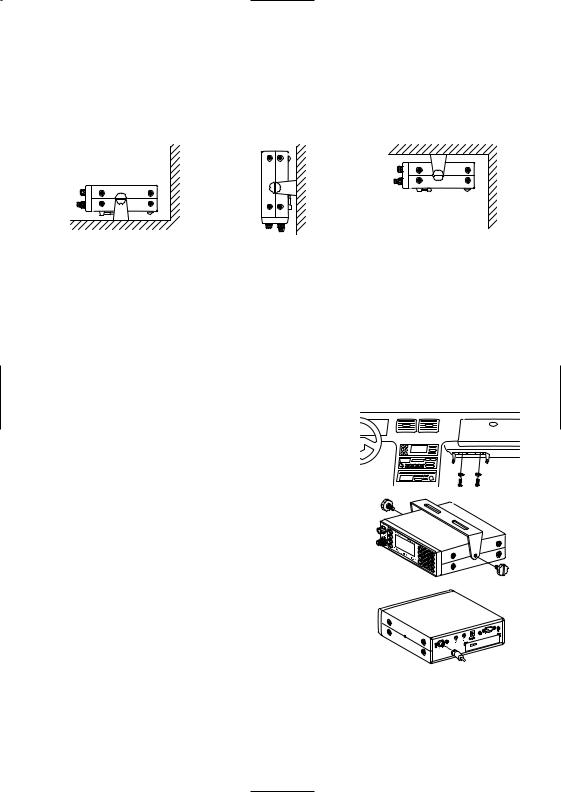
Typical Mounting Methods
The BC780XLT can be conveniently mounted on a table, bulkhead, overhead, or any other desired location (refer to figure below for typical mounting methods).
Caution: Make sure there are no hidden electrical wires or other items behind the desired location before proceeding. Check that free access for mounting and cabling
is available.
• Table top mount • Bulkhead mount • Overhead mount
Mounting the Scanner in Your Vehicle
Before you mount the scanner, make sure you have all the necessary materials. Then confirm that the scanner fits your vehicle’s mounting area. This unit requires a mounting area of 2-3/8 inch high by 6-15/16 inch wide by 6 -9/16 inch deep (61 x 176.5 x 167 mm).
Caution: Be sure to avoid obstructions behind the mounting surface.
Follow these steps to mount the scanner in your vehicle.
1. Choose a mounting location, then use the supplied mounting bracket as a template to mark the positions for the mounting screw holes.
2. In the marked positions, drill holes slightly smaller than the supplied screws.
3. Attach the mounting bracket to the mounting location using the supplied screws and lock washers.
4. Attach the scanner to the mounting bracket using the supplied mounting knobs.
5.Connect the antenna’s cable to the ANT. connector on the back of the scanner.
Note: If the antenna cable’s connector does not fit in the ANT. connector, you might also need a Motorola-to-BNC antenna plug adapter (available at a local
electronics store).
8
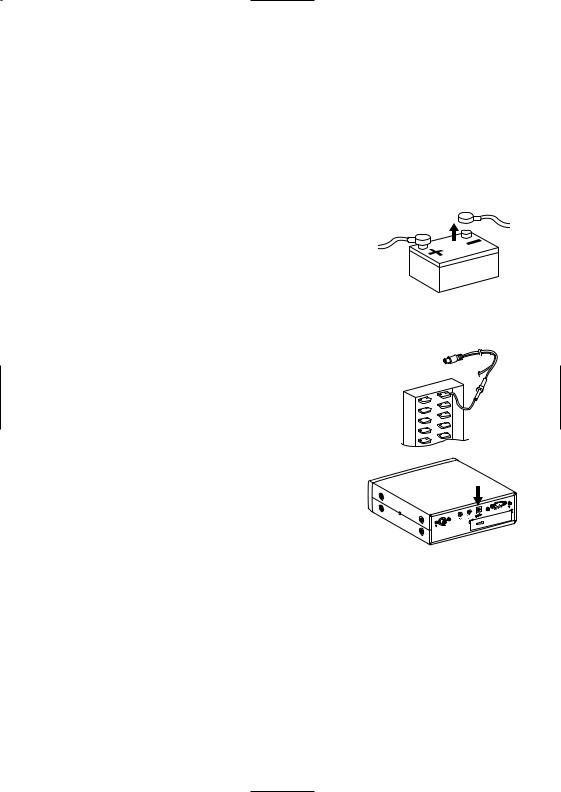
Applying Power for Vehicle Installation
You can power your scanner using either the supplied DC power cord or your vehicle’s cigarette lighter socket using DC cigarette lighter power cord.
Caution: You must use a power source that supplies 13.8 V DC and delivers at least
700 mA. Your standard 12V car battery should be sufficient. The cord connector’s center tip must be set to positive and its plug must fit the scanner’s DC 13.8 V jack. The supplied DC power cord meets these specifications. Using a power cord that does not meet these specifications could damage the scanner or the adapter.
•Always connect the adapter or DC power cord to the scanner before you connect it to the power source. When you finish, disconnect the adapter or DC power cord from the power source before you disconnect it from the scanner.
• For added safety and to protect your scanner, disconnect the cable from your vehicle battery’s negative (-) terminal before you begin.
Follow these steps to connect the supplied DC power cord.
1.Connect the power cord’s black wire to a chassis ground, such as a metal screw attached to a metal part of the vehicle’s frame. Be sure that the screw is not insulated
from the frame by a plastic part.
2. Connect the power cord’s red wire (with in-line fuse) to a source of voltage that turns on and off with the ignition switch, such as a spare accessory terminal in your vehicle’s fuse box.
3.Insert the power cord’s barrel plug into the DC 13.8 V jack on the back of the scanner.
4. Reconnect the cable to the vehicle battery’s negative (-) terminal.
To power the scanner from a vehicle’s 12 V power source (such as a cigarette-lighter socket), use the supplied cigarette-lighter adapter cord.
To connect the supplied DC cigarette-lighter power cord, insert its barrel plug into the DC 13.8 V jack on the back of the scanner, then plug the power cord into your vehicle’s cigarette lighter socket.
Note: If you use a cigarette-lighter power cord and your vehicle’s engine is running, you might hear electrical noise from the engine while scanning. This is normal.
9
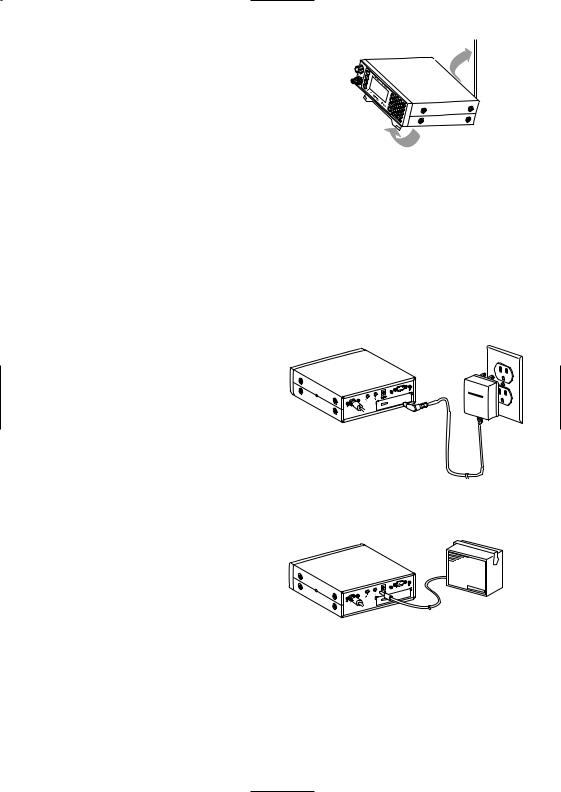
Desktop Installation
You can place this scanner on a desk, shelf, or table to use it as a base station.
1. Flip up the feet for desk installation.
2. Extend the antenna to full vertical position. Adjust the angle for best reception.
Applying Power Using Standard AC Power
To power the scanner from an AC outlet, use the provided AC adapter with a 5.5 mm outer diameter/2.1mm inner diameter tip.
Caution: You must use a Class 2 power source that supplies 13.8 V DC and delivers at least 700 mA. The cord connector’s center tip must be set to positive and its plug must fit the scanner’s DC 13.8 V jack. Using an adapter that does not meet these specifications could damage the scanner or the adapter.
•Always connect the AC adapter to the scanner before you connect it to AC power.
When you finish, disconnect the adapter from the AC power before you disconnect it from the scanner.
1.Insert the adapter’s barrel plug into the DC 13.8 V jack on the back of the scanner.
2.Plug the adapter into a standard AC outlet.
Note: Use only the AC adapter supplied with your scanner.
13. |
8V |
|
Connecting an External Speaker
In a noisy area, an external speaker (available at a local electronics store) positioned in the right place might provide more comfortable listening.
Plug the speaker cable’s 1/8 inch (3.5 mm) plug into your scanner’s EXT. SP. jack.
Note: Connecting an external speaker disconnects the scanner’s internal speaker.
10

Connecting an Earphone
For private listening, you can connect an earphone with a 1/8 inch (3.5 mm) plug to the
EXT. SP. jack on the back of the scanner. Be very careful as damage to your hearing can result if the VOLUME control is not set to the lowest level first. See below for “Listening Safely” instructions. (Your local electronics store should carry a wide selection of earphones.) Once the earphone is connected, it will automatically disconnects the internal speaker.
Listening Safely
To protect your hearing, follow these guidelines when you use an earphone or headphones.
•Do not use the earphone to listen to the WX alert siren test. The volume is not adjustable and damage to your hearing could occur.
•Do not listen at extremely high volume levels. Extended high volume listening can lead to permanent hearing loss.
•Set the VOLUME to the lowest setting before you begin listening. After you begin listening, adjust the VOLUME to a comfortable level.
•Once you set the VOLUME, do not increase it. Over time, your ears adapt to the volume level, so a volume level that does not cause discomfort might still damage your hearing.
Connecting the Clone Cable
You can transfer the programmed data to and from another BC780XLT scanner using an RS232C Cable (9 pin to 9 pin) (not supplied). Connect the cable between each scanner’s REMOTE jacks. See “Clone Mode” on page 66. You can also upload or download the programmed data to or from a PC using an optional PC interface kit available through your local electronics store.
Connecting the Tape Recorder
You can use a standard tape recorder or a VOX (Voice Operated Control) recorder.
To connect the recorder to the scanner, connect a cable with a 1/8 inch (3.5 mm) plug from the tape recorder’s remote jack to the TAPE OUT jack on the back of the scanner. (Your local electronics store should carry a wide selection of cables and tape recorders.) Refer to the “Record” section under “Additional Features” in the manual.
Remember!
•You must mark a channel, ID, talkgroup, or bank for Recording in order for this
feature to work. The LINE icon appears on all channels that have been properly marked.
•This feature does not work if your scanner is set with MUTE ON.
•The VOLUME control affects the Audio output. Do not set the volume on minimum. Make a trial taping to be certain the volume levels are set correctly.
Remote Programming Software
Software for remote programming and controlling the scanner is available for purchase by calling (800)722-6701 or through the website www.bc780xlt.com
11
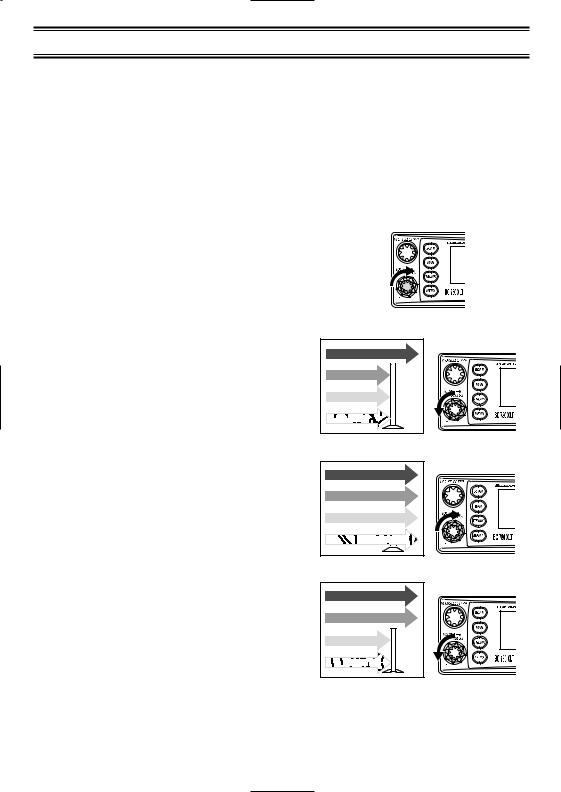
Basic Operation
Note: Fold out the Front Cover to see the Controls and Indicators while reading this Guide.
Turn the Scanner On
Turn the VOLUME control clockwise out of the detent position. The scanner automatically starts scanning. Since there are no frequencies programmed in your scanner initially, you may not receive any signals. Once you set the squelch and program some frequencies, you will be hearing conversations regularly.
Setting the Squelch
To set the squelch, you must be in the Manual mode, and you should not be receiving a signal on your scanner.
1. Press MAN until you do not hear a signal.
2. Make sure that the VOLUME is set to a comfortable listening level.
3.Think of the Squelch Control as a gate. Turn SQUELCH fully counter-clockwise. This raises the “Squelch Gate” so high that only very strong signals can get through.
4.Turn SQUELCH fully clockwise until you hear a hiss. This lowers the “Squelch Gate” so that everything gets through – noise, weak signals, and strong signals.
5.Turn SQUELCH back counter-clockwise just until the hiss stops. Now the “Squelch Gate” allows only clear signals through.
STRONG SIGNALS |
MEDIUM SIGNALS |
WEAK SIGNALS |
NOISE |
STRONG SIGNALS |
MEDIUM SIGNALS |
WEAK SIGNALS |
NOISE |
STRONG SIGNALS |
MEDIUM SIGNALS |
WEAK SIGNALS |
NOISE |
Next you must program some frequencies. (Page 20) It is recommended that you read the next part “Understanding the Menu System” because it will assist you in accessing and understanding many of the features. Later in a section called “Additional Features”, you will find explanations on how to disable the keypad acknowledgement tones, how to mute the audio, how to change the appearance of the display and other general features.
12
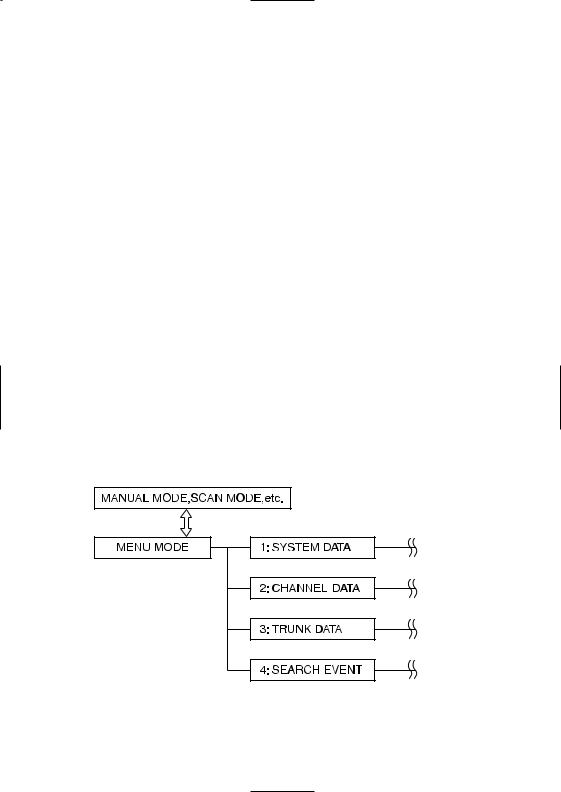
Understanding the Menu System
It is very important for you to understand the Menu screen. To navigate through the Menu screen is really quite simple. Many of the features of this scanner, can only be accessed by the menu screens. There are several ways to get through the screens. First of all, press MENU to get started. Any time you want to exit this mode or simply quit from where you are, repeatedly press MENU until the scanner returns to the original state. Anytime you are in the Menu Mode, the audio will be muted.
To assist you in understanding the Menu screen, flow charts are provided towards the back of the manual so you can follow along. Two things to remember are scroll through the menu and execute the command. For simplicity, we have chosen to use the up and down arrow keys (▲ and ▼) in order to scroll through the menu and the E key for entering or executing a command. Once you have pressed the E key and executed the final choice (for instance, ON or OFF), the display backs up to the previous level of options.
Other methods for scrolling through the menu screen include rotating the VFO control or press and hold the up and down arrow keys (▲ and ▼) in order to scroll more quickly. Also direct entry of the numbers in the flow chart will get you through the screens, but the other screen options are not visible. This method should be used only after you have gone through the manual at least once. A tearout shortcut card is provided in the front of the manual to assist you in the direct entry method for commonly used features.
Another method for entering or executing the command, press the SELECT/MUTE key or press the VFO/SELECT control.
Below is the first level of the Menu screen. These levels are then expanded on the foldout towards the back of the manual. You will find a description section to explain the meanings of these functions on the next few pages. Then, you will be walked through all the steps of programming, scanning, searching, and trunktracking.
13

Menu Description and Numeric Keypad Equivalents
Below are the menu screens and a brief description or purpose of the feature.
1:SYSTEM DATA
1:DIMMER
Allows you to change the brightness of the display.
2:SCREEN MASK
Screen Mask allows you to limit what appears on the display to the alpha tags that you have set for a channel along with a few function icons. Screen Mask removes the frequency, receiving mode, tone data, signal strength bars, and the trunking repeater activity indicators. This mode is particularly useful in public safety vehicles where “information overload” is already a problem. Screen Mask does not work in Search mode.
3:KEY BEEP
Use this function to turn off the keypad acknowledgement beep. The default setting is on.
4:ENTER LOCK
Use Enter Lock to prevent accidental re-programming of channels and talkgroups entered into memory. The default setting is off.
5:PC CONTROL
Use this function to set the transfer speed (baud rate) at which your personal computer (PC) communicates with the scanner when downloading information into your scanner using the Uniden national database or third party software. See page 65 for details.
6:CLONE
You can clone all the programming, including frequencies, talkgroups and alpha tags as well as bank settings and other parameters from one BC780XLT to another.
7:SMARTSCAN
Download frequencies, talkgroups and alpha tags for any area of the 50 states from the Uniden national database using the modem in your PC or a stand alone modem. Refer to page 59 for details.
8:DATA SKIP
A scanner will normally stop on any transmission it receives. This means the BC780XLT will occasionally stop on data signals and unmodulated transmissions. You can automatically skip many of these types of transmissions during search.
9:SQUELCH MODE
The Squelch Mode allows you to set, at your option, whether the scanner will stop on all active transmissions on a particular frequency or it will only respond to transmissions with a pre-set sub-audible tone. This applies to both conventional search and scan modes.The options are as follows:
1.CSQ - The default setting is CSQ (carrier squelch). In this mode the scanner will stop on any transmission on a programmed frequency (Squelch mode does not apply to trunking).
2.Tone SQ - In Tone Squelch mode, if you have set a subaudible tone (CTCSS or DCS) for a frequency, the scanner will only stop on that frequency if the transmission includes the prescribed tone.
14

3.Tone Search - In this mode, as soon as the scanner stops on any (non-trunked) channel, the scanner will begin to search for any subaudible tone that is being used on a transmitted frequency. The scanner will check each CTCSS tone sequentially and it will find DCS tones instantly.
10:BANK TAG
Allows you to set an alphanumeric text tag for individual banks in the scanner (1-10).(The “0” key represents Bank number 10.) For example, you may wish to set the Bank One text tag as Law Enforcement, the second bank as Fire, etc.
2:CHANNEL DATA
Choose the channel number. The following options are available for the selected channel only. Repeat using a different channel number, if necessary.
1:ALPHA TAG
Allows you to set an alphanumeric text tag for individual frequencies that you have programmed. For example, you can set DAVIS PD CH #3.
2:DELAY
The default delay for all programmed channels and talkgroups is two seconds. At the end of any transmission the scanner will remain on the frequency for two seconds before resuming scanning. This will allow you to catch most replies. You can change the delay to 1, or 4 seconds as well as set no delay (the scanner will immediately resume scanning after the end of a transmission). With the BC780XLT you can also set negative or inverse delays, also known as Pause. With a 5 second pause, for example, the scanner will resume scanning after five seconds even if the transmission you are currently listening to has not ended. Finally, you can set an Infinite Delay. If a transmission is received on a frequency with Infinite delay set, the scanner will stop on the channel and remain on it until you have hit scan,
search, etc.
3:TONE DATA
You can set a CTCSS (analog) or DCS (digital) sub-audible tone for a frequency. To do so you must have the Squelch Mode in the System Menu set to Tone Squelch. You can also program a subaudible tone easily by pressing the E (enter) key after programming a frequency. This will bring up the Tone Data menu without your having to navigate the Menu. You can also lock a tone assigned to a frequency. By doing this you will receive all transmissions on the frequency, regardless of the subaudible tone, except the one which you have locked. Any transmissions with that tone will not be received.
4:BEEP ALERT
You can set a Beep Alert on a per-channel basis to alert you when specific frequencies are active. For example, you may wish to be alerted anytime a mutual aid fire frequency is active. With beep alert, you will hear a rapid three-beep tone at the start of each transmission that you have flagged as such. You will also notice that as you scroll pass the flagged channel(s), you will hear the tones.
5:ATTENUATOR
The BC780XLT comes with an RF Attenuation feature. If you are near an unusually strong signal source, the signal may overload the scanner. The scanner may stop repeatedly on that signal and miss other transmissions.
The RF Attenuation feature works in all modes and attenuates (reduces) the incoming signal strength to prevent stronger signals from overloading the scanner.
15

6:STEPS
Your BC780XLT is programmed with default step sizes for each frequency range (see inside front cover). Steps are important if you are interested in using the VFO to tune off-frequency from a frequency programmed into memory or if you wish to program a frequency that the default step size will not accept. For example, in VHF Hi-band mode, the default step size between 148 and 162 MHz is 5 KHz. However, the FCC has recently instituted 7.5 KHz channel intervals. If you wish to enter 155.4075 into the scanner without changing the default step, the scanner will change the programmed frequency to 155.4100. Use the menu to change the default step size to 7.5 KHz and then you will be able to enter 155.4075.
7:MODE
Default receive modes are also programmed into memory. AM for the aircraft and CB bands, for example. All frequencies (other than TV broadcast audio) above 400 MHz are received in NFM mode which helps prevent adjacent channel interference. You can change the default settings on a per-channel basis with this Menu item.
8:RECORD
You can flag any channel for recording using this menu function. The LINE icon will become active for any such flagged channel. Use your own recording device plugged into the jack on the back of the scanner.
3:TRUNK DATA
Choose the Trunk bank. The following options are available for the selected trunk bank only. Repeat using a different trunk bank, if necessary.
1:TRUNK TYPE
You will need to assign the correct trunking type for the bank you are about to program. If you want to listen to a Motorola Type 1 system, you will need to use this menu option to assign the same. If you do not know the type of trunking system you are about to monitor, refer to the guide included with the radio or check out www.trunktracker.com.
Note: Some trunking systems require that you know the channel order. In these cases you will also need to start programming the trunked system at the start of the bank. The scanner defaults to the most common type of trunking system, Motorola Type II.
2:DELAY
You can set delay for a trunk system on a bank by bank basis. If you’ve set delay for 1 second, then there will be a one second delay in Trunk Search for that bank and a one second delay for all the talkgroups you have programmed into Scan List memory. You cannot set delay individually by talkgroup. The default delay is
two seconds.
3:RECORD
This Record option applies to Trunk Search. If you have set Record on, the LINE icon will be lit. All talkgroups received during Trunk Search will be recordable through the TAPE OUT jack on the back of the scanner. To record individual talkgroups during Scan, see Item 5 on the next page. The default is off.
16

4:L/O ID REVIEW
Use this menu item to review the IDs that you have locked out during Search and Scan. Use the Up/Down arrow keys or turn the VFO to the left or right to view the IDs that have been locked out. To leave the lockout IDs unchanged, press MENU to back out of the menu. To unlock an ID, press the L/O key. To unlock all the IDs that have been locked out, press the E (Enter) key.
5:PROGRAM ID
You can program IDs into Scan List memory either during Trunk Scan or Search without going into the Menu. However, you can also use the Menu to program IDs. This is particularly helpful when you are not near the trunked system you wish to later monitor. You can set it up and have it ready to go at some later time.
After you have selected the Scan List location (1-10) and the memory location (1-10), you can then do the following:
1Program the talkgroup or I-CALL ID number
2Set an alpha tag for same
3Assign the Record option for same. Whenever a transmission is active on the ID the signal can be recorded to a tape recorder using the TAPE OUT jack on the back of the radio.
4.Assign a Beep Alert to the ID. Whenever that ID is active, you will hear a rapid three beep tone at the start of the transmission.
6:ID LIST TAG
Assign an alphanumeric tag to any or all of the 10 Scan Lists for the system. During Scan Mode, you will see the List Tag (on the bottom text line) along with any alpha tag you may have set for an ID. In Search mode, you will see any Bank Tag you have set.
7:I-CALL (MOTOROLA AND EDCS)
Most communications within a trunked system are group calls where one unit (such as a dispatcher) communicates with all the units within his/her group (all the patrol vehicles on the east side of town, for example). The units within this group comprise what is typically known as a talkgroup. There are some communications which are direct unit-to-unit conversations where one individual converses with another individual. The call is initiated by a radio and is directed to another single radio. Within the system, no one outside of these two users hears the conversation.
Your BC780XLT defaults to I-CALL OFF mode. You can hear these conversations by using this Menu item to turn the I-CALL function to ON. In Search mode, with I-CALL on, you will hear both talkgroup calls and I-CALLs. You can also set I-CALLs to I-CALL ONLY during which you will monitor only I-CALLs in Search mode. You can also program I-CALL IDs into Scan List memory.
OR
7:ID SCAN LIST (LT)
When scanning an LT system you can only turn Scan Lists off and on when an LT talkgroup that you have entered into memory is active. To provide you with another method to turn Scan Lists on and off, you can use this Menu item which only appears when you have selected LT in Trunk Type.
17

8:STATUS BIT (MOTOROLA)
On Type II trunking systems there is a method by which specialized types of communications utilize unique talkgroup numbers. An emergency call will occur on a unique talkgroup from its primary assignment, for example. Because the BC780XLT defaults to Status-Bit On mode, you never need to worry about missing these transmissions. If you've programmed talkgroup 33264 into Scan List memory, for example, and there is an emergency call within the group, you will hear it on 33264.
OR
8:EDACS ID FORM (EDCS)
You can change to display the talkgroups in decimal mode, but this mode does not provide you with nearly the flexibility that you get with AFS. The BC780XLT defaults to show the talkgroup number in AFS mode (Agency-Fleet-Subfleet). For details on AFS see pages 50-51.
9:END CODE (MOTOROLA)
When this function is disabled, the radio looks for squelch before returning to the control channel instead of waiting for the disconnect tone. Only in rare instances will you need to adjust the default settings.
The condition to return to control channels depends on whether signal is present or not.
0:CONTROL CH ONLY (MOTOROLA 800 & 900 SYSTEMS)
With this mode you will be able to track Motorola Type I and II 800 and 900 MHz trunked systems by simply entering the control channel which manages the trunked system. You will not have to program the voice channels. There are 4 channel plans which you can select from.
4:SEARCH EVENT
You can program up to 10 search ranges (one per bank). The first time you program a range for a bank you will need to do so through the Menu. After the first time you can program a range as you do on most any other scanner, using the numeric keypad and the ▲/HOLD or ▼/LIMIT keys.
1:SEARCH BANK
Use this Menu item to select the search bank that you want to program. You can program banks 1 through 10, one at a time. For each of the banks, the following options can be modified.
1:EDIT RANGE
Enter the upper and lower frequency limits of the search range.
2:STEPS
You can assign a variety of step sizes to the search range. Note: The default step is usually acceptable and is listed in the front of the manual. (See inside front cover)
3:MODE
You can change the default receive mode with this menu item.
4:ALPHA TAG
You can alpha tag any or all of the search banks.
18

2:DELAY
Set a delay for the search ranges. This applies to all ranges (See CHANNEL DATASTEPS for details).
3:ATTENUATOR
Set attenuation for all search ranges. (See CHANNEL DATA-ATTENUATOR for details).
4:TONE DATA
The default mode is off. This means that you will receive all transmissions on any frequencies that are active within your search range(s). By selecting CTCSS or DCS you can set the radio to receive only a particular subaudible tone to be received during your search. You can also lockout a particular CTCSS or DCS tone. You may wish to do this if you want to search a range but not hear transmissions on any frequency that have particular subaudible tone.
Note: Through the System Menu you can set the radio to operate in Tone Search mode during Search as well. In this mode, the radio will automatically determine the active subaudible tone on any frequency received during the Search.
5:RECORD
With Record set to on, any frequency that is active, during the search, can be recorded to an external tape recorder.
6:AUTO STORE
You can automatically store active frequencies found during a search into memory. You can select which bank you want to program the found frequencies. Note that the audio will be muted during Auto Store.
19
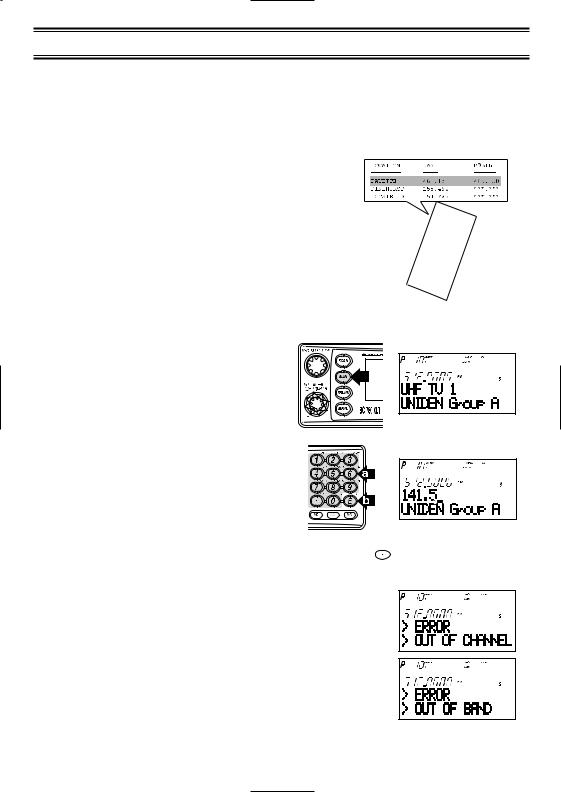
Programming
Before the BC780XLT can begin conventional scanning, you must program a frequency into at least one channel. Repeat this procedure for each channel you want to program.
Storing Frequencies into Channels
1.Select frequencies from your dealer, from various sources on the internet, or from one of
the guides listed on page 5.
Here is a list of sample frequencies you should try:
156.800 Marine Calling channel
155.340 Ambulance operations
155.280 Ambulance operations
155.160 Ambulance operations
462.950 Ambulance operations
462.5625 Family Radio Services (channel one)
2.Press MAN.
3.Select a channel.
a. Enter the channel number. b. Then press MAN.
4. Enter the frequency.
a. Enter the frequency number. b. Then press E.
Note: • To clear a mistake while entering the frequency, press |
(decimal key) repeatedly |
until the display is cleared. |
|
• If you enter a channel or frequency which is out of the scanner’s range, a distinctive beep will sound and ERROR appears in the display.
•You can use ▲ or ▼ when selecting a channel.
Press and hold ▲ or ▼ for 1 second to move up/down more quickly.
20
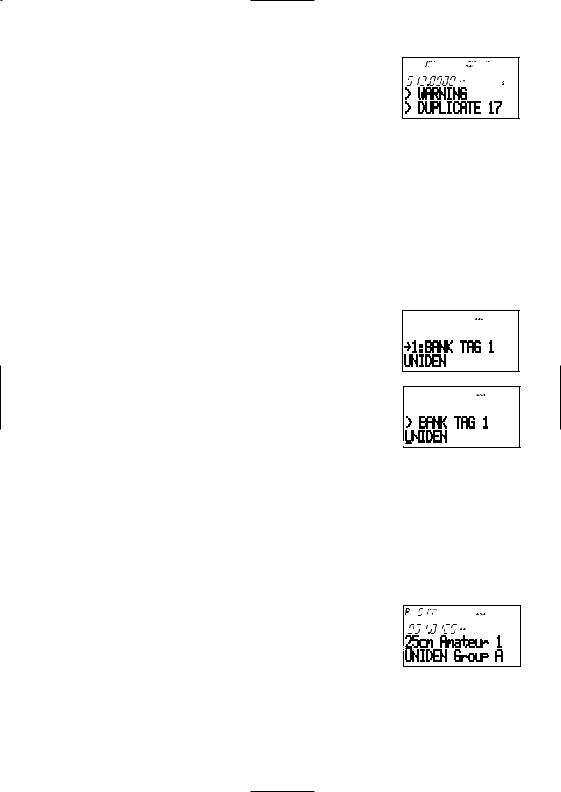
Duplicate Frequency Alert
If you enter a frequency which has been stored in another channel, you will hear a beep and the other channel displays WARNING.
Press  to clear and start again.
to clear and start again.
––– OR –––
Press E again to store the frequency in both channels.
Storing Text Tags
You can customize your scanner by storing text tags for easy identification of banks, channel transmissions, trunking talkgroup IDs, etc. The text tags can be set at the menu mode. (Refer to Understanding Menu System on page 13.)
Assigning a Bank Tag to a Bank
1.Press MENU.
2.Press E to select SYSTEM DATA.
3.Press ▲ or ▼ to select BANK TAG and then press E.
4. Select the bank number to be tagged using ▲ or ▼ and then press E.
5. The cursor appears on the display. Rotate VFO to change letters, and then press ▲ or ▼ to shift right or left. Both capital and lower case letters are available, as well as numbers and punctuation marks.
6. After entering the desired text, press E or SELECT.
Remember! You can also use the VFO control for scrolling. To clear a mistake while entering the frequency, press  (decimal key) repeatedly until the display is cleared.
(decimal key) repeatedly until the display is cleared.
Assigning a Text Tag to a Channel
1.Press MENU.
2.Press ▲ or ▼ to select CH DATA and then press E.
3.Select the channel number to be tagged using ▲ or ▼ and pressing E. You can also enter the channel number in using the keypad and then press E.
4. Press ▲ or ▼ to select ALPHA TAG and then pressing E.
Note: • If you have not stored a frequency in the channel,
UNREGISTERED will appear in the display.
5.The cursor appears on the display. Rotate VFO to change letters, and press ▲ or ▼ to shift right or left. Both capital and lower case letters are available, as well as numbers and punctuation marks.
6.After entering the desired text, press E, SELECT or VFO.
21

Beep Alert
The scanner can alert you with three rapid beeps at the beginning of a transmission on an assigned frequency.
Assigning the beep alert to a channel
This alert can be set on/off to every channel (or to every ID memory for Trunking mode).
1.Press MENU.
2.Press ▲ or ▼ to select CH DATA and then press E.
3.Select the channel number to be tagged using ▲ or ▼ and then press E. (You can also enter the channel number in using the keypad or VFO control and then press E.)
4.Press ▲ or ▼ to select BEEP ALERT and then press E.
5.Press ▲ or ▼ to select ON or OFF and then pressing E.
Note: If NOT REGISTER appears, make sure a frequency is stored in the channel.
Programming Tips
•Do not program a weather frequency into one of the channels, since weather channels transmit continuously. Use the Weather Search feature to select the weather information band.
•Group similar services into a bank. For example, program police frequencies in channels 1 through 10 and fire/emergency into channels 51 through 60, and so on.
•Put the frequency that you listen to the most or the most important frequency into a Priority channel.
•To quickly program a series of channels, start with the lowest number channel.
For example, when you are programming five new frequencies into Channels 4 through 8, start with Channel 4. After you finish programming a channel, press MAN or HOLD/▲ to go to the next higher channel.
•Write down your programmed channels and frequencies and put in a convenient place in case of accidental reprogramming.
•If you want to download frequencies using the SmartScan feature, go to page 59 in this manual.
•Frequencies are rounded off according to the step of each channel.
•When you are overwriting a tagged channel with a new frequency, the previous alpha tag
will be deleted. You must re-enter the alpha tag.
•When programming frequencies, a 2 second delay is set automatically but can be changed in the Channel Data menu.
Deleting a Stored Frequency |
|
|
To delete a stored frequency: |
|
|
a. Select a channel. |
SERVICE SEARCH |
|
b. Press 0. |
||
PUBLIC SAFETY |
||
c. Then press E. |
||
|
Note: Channels with no frequencies are automatically locked out.
22
